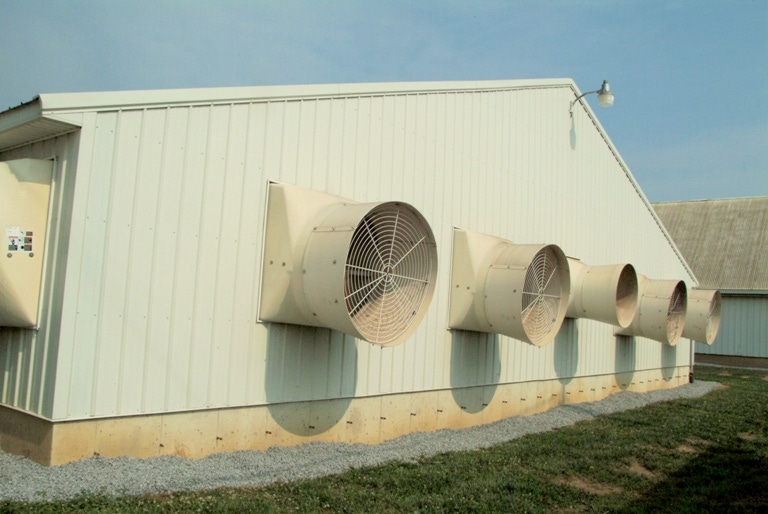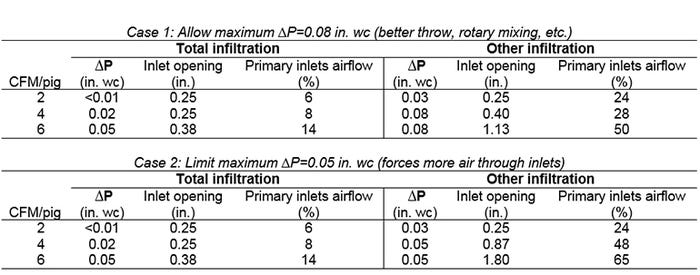Infiltration affects static pressure difference across the room envelop and how much air actually passes through the ceiling inlets and enters the room as a jet suitable for fresh-air mixing.
March 21, 2018

By Brett C. Ramirez, Steven J. Hoff, Jay D. Harmon, Iowa State University Department of Agricultural and Biosystems Engineering
Following up last month’s column about a recently completely study at Iowa State University (Iowa Pork Producers Association NPB Project 13-213) on infiltration rates measured from 17 wean/grow-finish rooms, this column will discuss and show, how infiltration affects static pressure difference across the room envelop and how much air actually passes through the ceiling inlets and enters the room as a jet suitable for fresh-air mixing. First, we’ll discuss the ideal operation of inlets during cold/mild conditions in a traditional negative pressure ventilation system, then, translate the research results to what it means in barns.
To recap, the primary inlet system is designed by engineers to ensure proper distribution of fresh air and mixing to remove generated gases and moisture from the animal occupied zone. Ideally, cold, fresh air exiting the inlet travels along the ceiling, warming up in the process, then reaches the pigs, and carries away “dirty” air to the exhaust fans. If designed correctly, the flow capacity per inlet, number of inlets and opening area of each inlet will provide this ideal rotary airflow pattern and create a uniform, well-mixed environment inside the room. The problem is, during the design phase, engineers assume a certain static pressure and thus, airspeed from the inlet. This is achievable in operation when all the design ventilation air is passing through the inlets.
However, the reality is, infiltration provides an alternative route for cold air to enter through unplanned inlets, directly bypassing planned inlets, and subsequently decreasing the operating static pressure. Infiltration can develop stale pockets of non-uniform and undesired environments in a room and in winter, can develop cold drafts around/nearby cracks. Wind effects can become amplified and decrease planned inlet performance. Infiltration has also been identified as a cause of building component deterioration, especially for positive pressure ventilation systems (exfiltration).
The scenario. Let’s analyze the impact of infiltration on static pressure, inlet opening size and the percent of fresh air that enters through the inlets. First, let’s recap the two categories of infiltration: total and other. Where, total infiltration is infiltration through curtains plus fans/pump-outs plus other. So, if we are able to (and we can) manage curtain and fan/pump-out infiltration by sealing holes, fixing shutters, etc. — we are left with other (endwall/sidewall joints, ceiling panels, etc.), which is not so easy to fix. Moving on, we’ll assume a typical finishing room housing 1,080 pigs at 7.5 square feet per pig and 8-foot ceiling height. There are 10 ceiling inlets (bi-flow, each 2-feet long). Also, we’ll analyze three typical ventilation rates 2 cubic feet per minute per pig, 4 cfm per pig and 6 cfm per pig.
Let’s ventilate at 2 cfm per pig in the hypothetical scenario where the barn is impacted by the total infiltration rates found in our study. Assuming a minimum inlet opening of 0.25 inches (probably not possible), the resulting static pressure would be <0.01-inch water column, and only 6% of fresh air goes through the planned ceiling inlets. Air not entering a room from the planned inlets is potentially causing cold drafts affecting animal comfort and performance, in addition to ineffectively removing “dirty” air. In addition, this results in a velocity of 200 fpm at the inlet. This will surely result in a cold air jet drop and poor mixing. So, if we are able to seal and reduce the fans/pump-outs and curtain infiltration, and the barn operates at the other infiltration rates found in this study, the resulting static pressure would be <0.03-inch water column, and only 24% of fresh air goes through the inlets (assumes the same 0.25-inch opening). In addition, this results in a velocity of 550 feet per minute at the inlet. Better, but still not great.
Let’s now use a 6 cfm per pig ventilation rate and analyze the same scenario. At the total infiltration rate, a minimum desired static pressure of 0.05-inch water column is achieved with a 0.38-inch inlet opening with only 14% of fresh air going through the planned ceiling inlets at an exit velocity of 700 fpm at the inlet. Again, assuming we can mitigation fan/pump-out and curtain infiltration and reduce total to the other infiltration, and allow a maximum of 0.08-inch water column to develop, the inlet opening required is 1.13 inches and 50% of the fresh air comes from the planned ceiling inlets at a velocity of 890 fpm.
We could also reduce static pressure to increase the amount of fresh air that goes through the planned ceiling inlets. In our 6 cfm per pig case, we’ll limit the static pressure to be 0.05-inch water column, and at this operating static pressure requires an inlet opening of 1.8 inches resulting in 65% of the fresh air originating through planned inlets. Given our current systems, at 2 cfm per pig, it’s not quite practical to achieve 0.05-inch water column. The inlet opening would need to be less than 0.01 inches So, closing one side of the bi-flow inlets is an option, sacrificing proper fresh-air mixing further. Reducing infiltration is key. A summary of this interaction is found in Table 1.

Table 1: Summary of the interaction between static pressure differential (∆P), required inlet opening, and the percent of fresh air passing through the ceiling inlets if the hypothetical barn was operated at 2, 4 and 6 CFM/pig and the total and other infiltration rates found the ISU study. Assumes ceiling inlets can be adjusted to a minimum 0.25-inch opening.
Current infiltration rates are at a level that is substantially affecting our ability to provide optimal ventilation system performance and fresh-air distribution during cold-weather conditions. The vast majority of fresh air during lower ventilation rates is originating from unplanned locations and not the planned inlet system itself. General rule of thumb: as ventilation rate increases, infiltration rate increases, and the percent of fresh air going through the ceiling inlets also increases (i.e.: percent of fresh air entering through leaks decreases), but for a constant ventilation rate at a lower operating static pressure, percentage through the ceiling inlets increases.
You May Also Like


